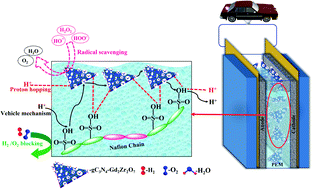Porous gC3N4–Gd2Zr2O7 enables the high-temperature operation of Nafion membranes in polymer electrolyte fuel cells over 500 hours†
Abstract
Nafion, a perfluorosulfonic acid (PFSA) polymer, is a vital electrolyte that extensively contributes to the commercialization of polymer electrolyte fuel cells (PEFCs). However, adopting Nafion in high-temperature (HT) PEFCs (HT-PEFCs) is still a great challenge. Herein, we present a potential additive (carbon nitride–gadolinium zirconium oxide (gC3N4–Gd2Zr2O7)) to simultaneously extend the power density and lifetime of Nafion in HT-PEFCs. Owing to the porous nature, radical-scavenging ability, and thermal stability of gC3N4–Gd2Zr2O7, the Nafion/gC3N4–Gd2Zr2O7 membrane exhibited high water uptake, oxidative stability, and thermomechanical stability compared to the unmodified Nafion membrane. At 100 °C under 30% RH, the maximum power density of Nafion/gC3N4–Gd2Zr2O7 was 504 mW cm−2 at a load current density of 804 mA cm−2, which is 1.9 and 2.3 fold higher than that of commercial Nafion-212 and pristine Nafion membranes. Moreover, Nafion/gC3N4–Gd2Zr2O7 displays an open-circuit voltage (OCV) decay of 0.1 mV h−1 during 515 h of continuous operation, which is significantly lower than that of the Nafion membrane during the 300 h durability operation (2.8 mV h−1). When increasing the operating temperature to 125 °C under 15% RH, the Nafion/gC3N4–Gd2Zr2O7 based PEFC largely outperforms the Nafion-212 and pristine Nafion-based PEFCs, achieving an output of 380 mW cm−2, one of the most competitive HT-PEFC power densities reported for Nafion-based membranes. Post durability tests further ensure the superior stability of Nafion/gC3N4–Gd2Zr2O7 during HT-PEFC operation. The present study provides deep insight into developing and understanding of advanced Nafion composite membranes applicable for HT-PEFCs.



 Please wait while we load your content...
Please wait while we load your content...